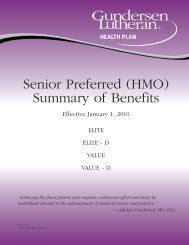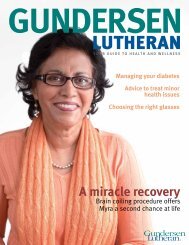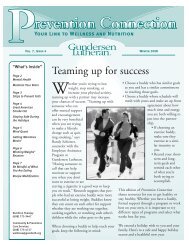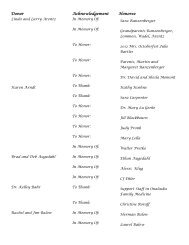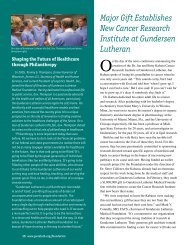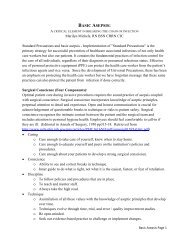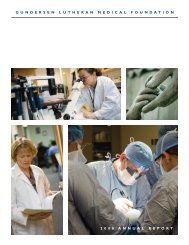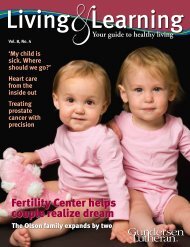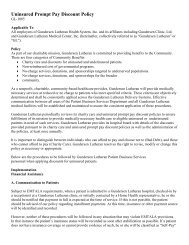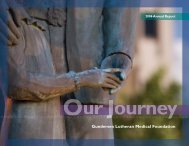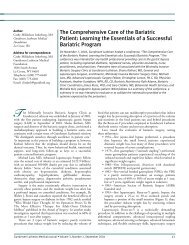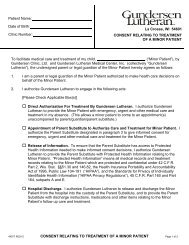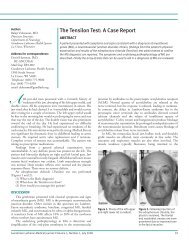ndersen er an - Gundersen Health System
ndersen er an - Gundersen Health System
ndersen er an - Gundersen Health System
You also want an ePaper? Increase the reach of your titles
YUMPU automatically turns print PDFs into web optimized ePapers that Google loves.
Surg<strong>er</strong>y Risty et al 395<br />
Volume 142, Numb<strong>er</strong> 3<br />
Table II. The risk of postop<strong>er</strong>ative stroke in<br />
patients with or without concomit<strong>an</strong>t carotid<br />
endart<strong>er</strong>ectomy<br />
Concomit<strong>an</strong>t CEA<br />
N 8<br />
No CEA<br />
N 28<br />
CEA, carotid endart<strong>er</strong>ectomy.<br />
P<strong>er</strong>iop<strong>er</strong>ative<br />
stroke<br />
No p<strong>er</strong>iop<strong>er</strong>ative<br />
stroke<br />
2 6<br />
0 28<br />
Av<strong>er</strong>age length of follow-up was based on the<br />
numb<strong>er</strong> of months from op<strong>er</strong>ation to most recent<br />
clinic visit. Follow-up r<strong>an</strong>ged from 1to 212 months<br />
(me<strong>an</strong>, 66 months). Symptom resolution was det<strong>er</strong>mined<br />
by history <strong>an</strong>d physical exam. One patient<br />
was lost to follow-up. All remaining patients (97%)<br />
had relief of symptoms.<br />
Twenty-five p<strong>er</strong>cent (2/8) of patients who und<strong>er</strong>went<br />
concomit<strong>an</strong>t CEA sustained post-op<strong>er</strong>ative<br />
stroke, 1each with CST <strong>an</strong>d CSB (Table II). No<br />
patients who und<strong>er</strong>went CSB or CST alone had a<br />
post-op<strong>er</strong>ative stroke. The risk of postop<strong>er</strong>ative<br />
stroke in patients with concomit<strong>an</strong>t CEA was signific<strong>an</strong>tly<br />
high<strong>er</strong> th<strong>an</strong> the risk of stroke aft<strong>er</strong> CSB or<br />
CST alone (P .044).<br />
Twelve studies from the English l<strong>an</strong>guage lit<strong>er</strong>ature<br />
since 1990 had sufficient information to<br />
compare the rate of p<strong>er</strong>iop<strong>er</strong>ative stroke in patients<br />
und<strong>er</strong>going CST or CSB alone v<strong>er</strong>sus those<br />
who had concomit<strong>an</strong>t CEA with CST or CSB<br />
(Table III). 11-22 Th<strong>er</strong>e w<strong>er</strong>e only 2(0.34%) strokes<br />
in 589 patients und<strong>er</strong>going CSB or CST alone v<strong>er</strong>sus<br />
5 (3.57%) strokes in 140 patients who had<br />
concomit<strong>an</strong>t CEA with CST or CSB. This diff<strong>er</strong>ence<br />
was signific<strong>an</strong>t (P .004). Adding our patients to<br />
these totals, th<strong>er</strong>e w<strong>er</strong>e 2 (0.32%) p<strong>er</strong>iop<strong>er</strong>ative<br />
strokes in 617 patients und<strong>er</strong>going CSB or CST<br />
alone v<strong>er</strong>sus 7(4.73%) p<strong>er</strong>iop<strong>er</strong>ative strokes in 148<br />
patients who had concomit<strong>an</strong>t CEA with CSB or<br />
CST. This diff<strong>er</strong>ence was signific<strong>an</strong>t (P .001).<br />
DISCUSSION<br />
Both CST <strong>an</strong>d CSB c<strong>an</strong> be p<strong>er</strong>formed with<br />
relatively low rates of mortality <strong>an</strong>d morbidity.<br />
Th<strong>er</strong>e w<strong>er</strong>e two deaths within 30 days in our<br />
s<strong>er</strong>ies, one aft<strong>er</strong> CSB <strong>an</strong>d one aft<strong>er</strong> CST. The<br />
p<strong>er</strong>iop<strong>er</strong>ative mortality rate following these two<br />
procedures reported in the lit<strong>er</strong>ature has r<strong>an</strong>ged<br />
from nil to 12%. 7,8,12,14,15,23-27 Edwards <strong>an</strong>d associates<br />
reported 2.2% ov<strong>er</strong>all mortality rate aft<strong>er</strong><br />
190 extrathoracic reconstructions, including 178<br />
CST. 14 Vitti et al. 15 reported one death aft<strong>er</strong> 124<br />
P<br />
.044<br />
Table III. Results of English-l<strong>an</strong>guage lit<strong>er</strong>ature<br />
review comparing the rates of p<strong>er</strong>iop<strong>er</strong>ative<br />
stroke aft<strong>er</strong> CSB or CST alone or with<br />
concomit<strong>an</strong>t CEA<br />
Ref<strong>er</strong>ence<br />
Year<br />
CSB/CST<br />
alone<br />
CSB/CST with<br />
CEA<br />
Defraigne 11 1990 0/24 1/5<br />
P<strong>er</strong>l<strong>er</strong> 12 1990 1/27 0/4<br />
Mingoli 13 1992 0/26 1/23<br />
Edwards 14 1994 0/177 2/10<br />
Vitti 15 1994 0/92 0/32<br />
Salam 16 1994 0/30 0/4<br />
v<strong>an</strong>d<strong>er</strong>Vliet 17 1995 0/35 0/7<br />
Schardey 18 1996 0/93 0/15<br />
D<strong>er</strong>iu 19 1998 0/30 1/10<br />
Toursarkissi<strong>an</strong> 20 1998 1/16 0/6<br />
Wittw<strong>er</strong> 21 1998 0/28 0/12<br />
Cina 22 2002 0/11 0/12<br />
Total 2/589 (0.34%) 5/140 (3.57%)<br />
P .004<br />
CSB procedures. S<strong>an</strong>dm<strong>an</strong>n <strong>an</strong>d cowork<strong>er</strong>s 27 documented<br />
a1.4% mortality rate in 72 patients who<br />
und<strong>er</strong>went CST. Procedure-related complications<br />
c<strong>an</strong> be grouped into sev<strong>er</strong>al categories. Thoracic<br />
duct leaks requiring reop<strong>er</strong>ation have been described<br />
by m<strong>an</strong>y investigators. 7,14-17,21,22,27 The incidence<br />
of thoracic duct leak c<strong>an</strong> be reduced by<br />
meticulous identification <strong>an</strong>d ligation of the main<br />
duct <strong>an</strong>d <strong>an</strong>y small lymph ch<strong>an</strong>nels with p<strong>er</strong>m<strong>an</strong>ent<br />
suture. Phrenic n<strong>er</strong>ve injury has been reported by<br />
m<strong>an</strong>y groups. 12,15-17,23,24,26 These injuries appear<br />
more frequently aft<strong>er</strong> CSB th<strong>an</strong> CST. Tr<strong>an</strong>sient <strong>an</strong>d<br />
p<strong>er</strong>m<strong>an</strong>ent Horn<strong>er</strong>’s syndrome are not infrequent<br />
following both CSB <strong>an</strong>d CST. 14,17,25,26 Recurrent<br />
laryngeal n<strong>er</strong>ve dysfunction has also been described.<br />
12,14,15,17,26<br />
Long-t<strong>er</strong>m results aft<strong>er</strong> both CSB <strong>an</strong>d CST w<strong>er</strong>e<br />
excellent in our s<strong>er</strong>ies. At av<strong>er</strong>age follow-up of<br />
more th<strong>an</strong> 5years, 97% of patients had relief of<br />
symptoms. Th<strong>er</strong>e was only 1patient in our s<strong>er</strong>ies<br />
who required thrombectomy for graft thrombosis<br />
<strong>an</strong>d th<strong>er</strong>e w<strong>er</strong>e no late op<strong>er</strong>ations for restenosis.<br />
M<strong>an</strong>y previous studies have documented impressive<br />
long-t<strong>er</strong>m patency rates aft<strong>er</strong> CSB <strong>an</strong>d CST.<br />
AbuRahma <strong>an</strong>d cowork<strong>er</strong>s 23 reported 92% primary<br />
<strong>an</strong>d 95% secondary patency rates at 10 years.<br />
Edwards et al. 14 discov<strong>er</strong>ed only one failure at 26<br />
months aft<strong>er</strong> 178 CST procedures. Owens <strong>an</strong>d associates<br />
24 calculated a 96.5% patency rate at a<br />
me<strong>an</strong> follow-up of 26 months aft<strong>er</strong> CSB. S<strong>an</strong>dm<strong>an</strong>n<br />
et al. 27 reported 95% patency rates aft<strong>er</strong> both CSB<br />
<strong>an</strong>d CST. Cina et al. 22 studied 23 patients by ultrasound<br />
at ame<strong>an</strong> of 25 months aft<strong>er</strong> CST; all recon-<br />
Gu<strong>nd<strong>er</strong>sen</strong> Luth<strong>er</strong><strong>an</strong> Medical Journal • Volume 5, Numb<strong>er</strong> 1, July 2008 31




